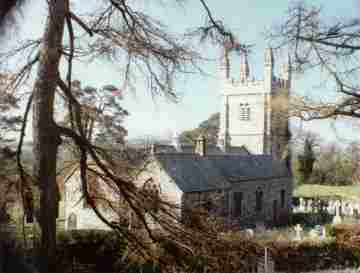|
Location and History
Lydford Church holds a fine
position at the south west corner of the village centre, high above the
gorge, between the site of
a previous Norman fortified castle and the still-standing Medieval castle
. The church is dedicated to St Petrock (alternatively written as "St
Petroc"), a Welsh monk who travelled extensively through the West Country
in the 6th Century and died in 564. There are at least twenty-seven
churches in Devon and Cornwall which bear his name.
Although the construction date of the first church in Lydford is not
clear, it seems possible that the location of it and of the present church
is that of a simple shelter used by St Petrock when visiting the
area. Of course this general region of Celtic people had been Christianised,
at least nominally, in the 4th century, following the official conversion of the
Romans from paganism in about 330, and it had remained so after the departure
of the Romans from Britain in 410; but, certainly, Christianity, in its
Romano-Celtic form, was re-invigorated in the two counties by the preaching
and work of St Petrock and his fellow monks. A date of 641 for the
"dedication of a church to St Petrock" in Lydford has been stated [Ref. 1,
below].
In the 7th century there had been the progressive
Saxon conversion to Christianity that followed the arrival in SE England
in about 600 of special emissaries from Rome. However, the date at which
the Lydford area came under Saxon rule is uncertain. The Saxons had moved
westwards from SE England and East Anglia, but, for example, did
not capture Cirencester and Bath until 577 [Ref. 2, p.38]. The same source
(p.54) states that
the River Tamar (which is the present Devonshire/Cornwall boundary) was the
western edge of Saxon Wessex by approximately 700. It seems likely
therefore that the first church construction of some kind in Lydford was
Celtic-Christian, and probable that a Saxon-Christian wooden church
was constructed on the same site in the 8th century, but with the
"St Petrock" name being retained and indicating an influence of the
Celtic Christians upon the incoming Saxons.
Saxon Christianity spread progressively and became formalised, and
dioceses and minsters existed in Exeter, Crediton, Plympton and Bodmin by
about 850 [Ref. 2, Map on p.71]. The fortified
Anglo-Saxon town ("burh") of Lydford was set up by King Alfred in about
880.
The Saxon wooden church in Lydford may have been burnt down by the Vikings when they attacked Tavistock and Lydford in 997AD, but it is possible that it lasted until well after the Norman Conquest of 1066. But nothing now remains of it. The
first mention of a stone church in the town/village is in 1237 [Ref.3].
After that, there are references to building work on the church in 1261 and in the middle of the fifteenth century. At one time a
considerable quantity of lead was taken from the roof of the church to
repair castles in Cornwall.
Structure, Wood Carvings and Village Models
Lydford Church is a fine and beautiful stone building with a tower, and well deserves to be visited.
A splendid feature of the inside of the Church is an excellent display of
intricate wood carvings that form the ends of the pews. These are all
different from each other and show a saint or other holy man surrounded
by a border of words or of animals and plants. There are creatures from
the sea and land, birds, insects, frogs and animals ranging in size from
rabbits to goats; there are also many exquisite flowers, amongst them
the primrose. Also in the church, at the back, there is a very interesting
display of models of the village.
The Windows in Lydford Church
Detailed Information by Howard Barkell
The Churchyard and the Watch-Maker
The churchyard is a peaceful place with wonderful views over the Devon countryside. One of the tomb-stones is particularly well-known and is that of a watch-maker,
George Routleigh. The epitaph on the lid of the tomb (now inside the church, fixed to a wall and illuminated) is a long and clever one, equating his profession
with his life, and it ends with the words:
He departed this life
Nov 14 1802
Wound up
In hopes of being taken in hand
By his Maker
And of being thoroughly cleaned, repaired
And set-going
In the world to come.
|
|

